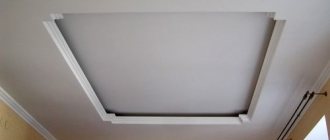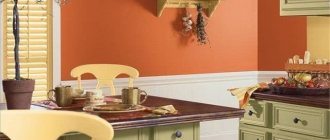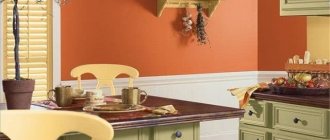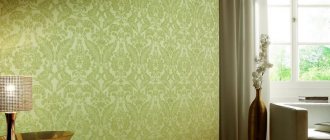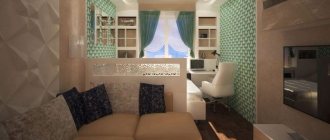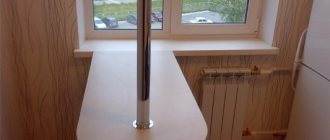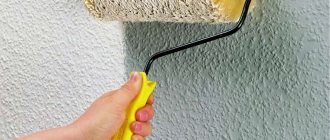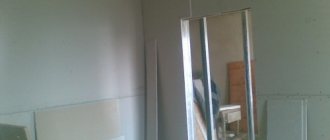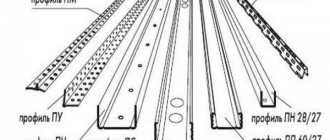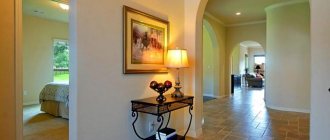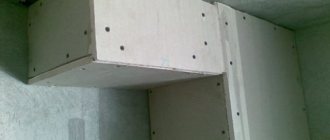Painting drywall, according to some ordinary people, is not difficult, because the surface of this material is smooth. But, as practice shows, everything is not so simple. Experts believe that in order to carry out the process efficiently and achieve the desired result, you need a special finishing of drywall for painting. What is meant?
Painting drywall
Preparatory work
- First of all, it is necessary to prime the joints between the panels and the places where the fastening screws are installed.
- Apply putty solution to the joints, filling them to the brim.
- Install the reinforcing tape (while the putty is still wet).
- After drying, apply another layer of putty over the tape.
- Completely prime the plasterboard sheets.
- After the primer has dried, apply a thin leveling layer of finishing putty. It will fill the grooves and depressions of the surface.
- After drying again, apply another layer, which will cover the entire plasterboard surface.
- The plasterboard structure must dry, after which the surface must be sanded. To do this, you will need fine-grained sandpaper or a special synthetic paint mesh. Grinding is done without pressure in a circular motion.
- Treating the plasterboard surface with a primer (this is about the question of how to coat the plasterboard before painting).
Please note that before applying the next layer of leveling or fastening material, the previous layer must be dried. This is a guarantee of the quality of the process.
Surface sanding and priming
Painting drywall in a room
Without additional processing, all areas of wall putty will stand out, regardless of the type of paint and the number of layers. Before painting the drywall, apply a coat of finishing putty. All irregularities and protrusions must be sanded with sandpaper. Then a layer of primer. If depressions of more than 0.5 mm remain, the treatment must be repeated.
Advice! To work with drywall, choose gypsum-based mixtures. They are homogeneous with the composition of the sheets. This ensures good adhesion and uniform shrinkage.
To ensure an even gloss of the paint, use putty to cover the entire surface of the walls or ceiling. The number of layers depends on the surface roughness. A thick layer of plaster can shrink and crack. Apply several thin coats if necessary and prime each coat. Each layer of material must dry completely.
The surface of gypsum board and gypsum putty absorbs moisture differently. All untreated areas of the wall will stand out with spots of paint with a different sheen and shade. This is not visible under the wallpaper. For painting, careful preparation is necessary for the entire wall surface.
Choosing paint for drywall
Painting drywall requires a certain approach to the choice of paint and varnish material. In this case there are some restrictions. For example, you cannot use oil paints. It is better to paint a plasterboard suspended ceiling with water-based emulsion (the matte color visually raises the ceiling).
Painting plasterboard walls will work better if you use water-dispersion paints or alkyd-based enamels. Although water-based emulsion is the best option on all planes.
- Firstly, it can be cleaned using a clean cloth and warm water.
- Secondly, this is a huge color palette.
- Thirdly, ease of application.
- Fourthly, the ability to remove paint and apply another finishing material or another type.
Related article: What comes first, wallpaper or laminate: tips on order of execution
Material selection
To paint gypsum board walls you will need to purchase a special water-based paint. When choosing it you should consider:
- Room humidity level.
- Possibility of sudden temperature changes.
Water-based emulsions are distinguished by their ability to impart a matte and velvety appearance to the painted surface. Their consistency can be changed by adding plain water if necessary and thoroughly mixing the contents of the bucket. This composition can be applied either with a brush or roller, or with a spray bottle. When purchasing, it is important to pay attention to the composition of the paint and its purpose.
The best materials for ceilings and walls
Modern manufacturers offer a wide range of water-based paints:
- acrylic;
- silicate;
- silicone;
- water-dispersed.
The most popular are water-based compositions that are suitable for any premises (industrial, technical, office, residential). They are distinguished by an affordable price and a fairly high level of quality. Water-based paint can be used to paint walls in the kitchen and bathroom, nursery and living room, hallway and office.
The created coating is considered breathable. The coating layer prevents the formation of condensation, prevents the formation of mold, and does not contribute to the accumulation of moisture on the surface. A significant drawback is the high consumption of material during painting. It can be reduced by using high-quality preliminary priming of the walls.
Painting drywall
Painting drywall requires some knowledge and experience with painting tools. Let's start with the fact that the optimal tool for applying paint to drywall is a paint roller. But please note that this tool must have a medium-pile coat. Why?
Drywall for painting - applying water-based emulsion
Over time, the long pile will pick up a large amount of paint and it will become difficult to work with. There are also problems with short pile; bald patches may remain on the surface. It is prohibited to use a foam rubber or velor roller (they leave marks and air bubbles on the surface to be painted).
How to paint with water-based emulsion
Let's look at this process using a ceiling as an example. Let us immediately note that water-based paint is applied on the surface, so to speak “on wet”. What does it mean? There is no need to wait for the first layer to dry.
The second thing I would like to draw your attention to. This type of finishing material is applied in two or three layers. Third, there is a specially established sequence for applying each layer of paint.
Attention! If the water-based emulsion is applied to the ceiling in two layers, then the first is applied across the room (parallel to the wall where the window is located), the second along. If the treatment is carried out in three layers, then the first and third layers are applied along the room, and the second across.
This is not difficult to understand; a sequence is required here, where the last layer of paint should always be applied only along the room. This is the whole secret of the process.
- Drywall paint
- Preparing drywall for painting
How to paint with enamel
With enamel it is a little more difficult and longer, because here you have to wait until the previous layer of paint dries (the drying time is indicated on the packaging). And its price is much more expensive than that of aquatic species.
Applying enamel - processing drywall for painting was a preliminary step
Related article: How to make a log house with your own hands?
It all starts with the fact that the material itself must be applied to the surface in the form of zigzag lines (possibly chaotically). And while it has not yet dried, you need to shade it over the entire surface. This means spreading it in a thin layer. Here you will need a brush.
But the second layer can be applied along the room in stripes that will overlap each other with a slight overlap. Usually, these two layers are enough for painting on drywall to be done efficiently.
Preparing drywall for painting
When installing plasterboard sheets, joints and recesses are formed from screwing in self-tapping screws. They need to be camouflaged. To do this, use putty or plaster, prepared from a dry mixture or ready-made.
- First, the entire wall area is covered with a primer.
- Then the joints between the sheets are sealed. Apply a thin layer of the prepared composition. A special mesh tape is applied on top. It reinforces the seam and prevents cracks from forming in the future. Particular care should be taken to plaster the joint between the wall and the ceiling, trying to maintain the ideal angle.
- Next, using a wide spatula, cover the entire area of plasterboard sheets to be painted with an even thin layer. This is necessary to hide the places where they are attached to concrete or wooden surfaces.
- At the end the primer is used again. It and the plaster will not allow the paint to be absorbed into the cardboard base.
Important! At the stage of preparing plasterboard sheets for painting, plaster is used. When choosing tinted paint, check how it will fit on this coating. To do this, a small fragment of the plastered cardboard surface is coated with a pigment composition. After 2-3 days, it will become clear what color the walls in the room will be with this composition option.
Useful tips
- The process starts with the corners (it doesn’t matter whether they are ceiling or wall corners). To do this you will need either an angled roller or a paint brush.
- Places where sockets, switches, etc. are installed are painted with a brush at a distance of at least three centimeters.
- If you paint plasterboard walls with your own hands, then the process must be carried out from the ceiling to the floor.
- Before using the paint, it must be stirred well. If it is thick, then the water-based emulsion is diluted with water, the enamel with a solvent.
- Treating drywall before painting requires priming (discussed above). It is recommended to use an acrylic primer for this.
- First of all, the joints between the panels are painted. After these areas have dried, you can begin painting the entire surface.
Painting the wall
How to paint drywall: detailed execution technology
Today, plasterboard sheets are one of the most popular materials for leveling walls. Due to their structure and smooth outer surface, gypsum boards are perfectly combined with any type of finishing. The current option for the latter is still painting the walls. To get a high-quality and aesthetic finish, you need to clearly understand how to paint drywall
competently and most effectively.
All types of paints do an excellent job, but the main selection criterion is the final desired result.
If you are painting drywall in a small room, it makes sense to create a glossy surface - paint the gypsum board using alkyd enamel.
It is worth noting that manufacturers are constantly improving their products and releasing them with more advanced properties. Now you can buy paint that is odorless or dries very quickly. Whatever is in demand will also be in supply.
This axiom is very clearly visible in the construction market of finishing materials. As practice shows, it is rational to use a flat brush, the width of which does not exceed 10 cm; the ideal option would be a thin flute brush. Having such a variety at your disposal, before going to the store you should already clearly know what you want to get in the end.
